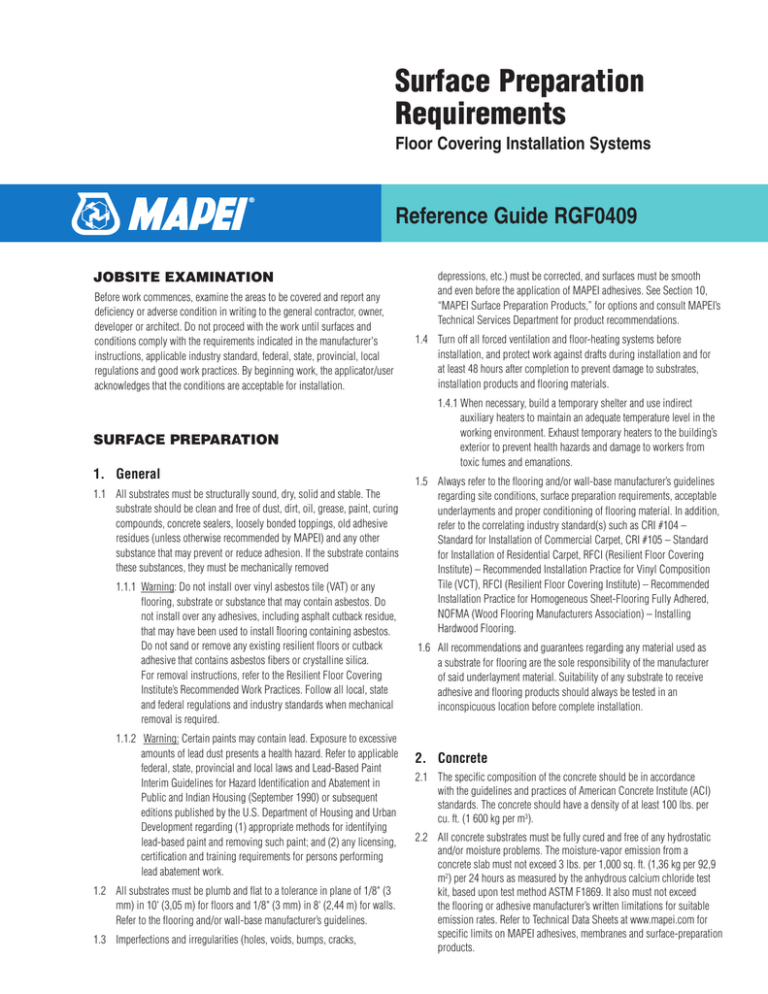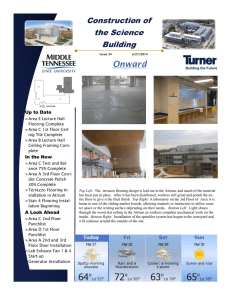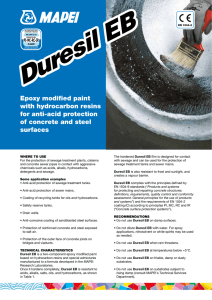
Surface Preparation
Requirements
Floor Covering Installation Systems
Reference Guide RGF0409
JOBSITE EXAMINATION
Before work commences, examine the areas to be covered and report any
deficiency or adverse condition in writing to the general contractor, owner,
developer or architect. Do not proceed with the work until surfaces and
conditions comply with the requirements indicated in the manufacturer's
instructions, applicable industry standard, federal, state, provincial, local
regulations and good work practices. By beginning work, the applicator/user
acknowledges that the conditions are acceptable for installation.
depressions, etc.) must be corrected, and surfaces must be smooth
and even before the application of MAPEI adhesives. See Section 10,
“MAPEI Surface Preparation Products,” for options and consult MAPEI’s
Technical Services Department for product recommendations.
1.4 Turn off all forced ventilation and floor-heating systems before
installation, and protect work against drafts during installation and for
at least 48 hours after completion to prevent damage to substrates,
installation products and flooring materials.
SURFACE PREPARATION
1. General
1.1 All substrates must be structurally sound, dry, solid and stable. The
substrate should be clean and free of dust, dirt, oil, grease, paint, curing
compounds, concrete sealers, loosely bonded toppings, old adhesive
residues (unless otherwise recommended by MAPEI) and any other
substance that may prevent or reduce adhesion. If the substrate contains
these substances, they must be mechanically removed
1.1.1 Warning: Do not install over vinyl asbestos tile (VAT) or any
flooring, substrate or substance that may contain asbestos. Do
not install over any adhesives, including asphalt cutback residue,
that may have been used to install flooring containing asbestos.
Do not sand or remove any existing resilient floors or cutback
adhesive that contains asbestos fibers or crystalline silica.
For removal instructions, refer to the Resilient Floor Covering
Institute’s Recommended Work Practices. Follow all local, state
and federal regulations and industry standards when mechanical
removal is required.
1.1.2 Warning: Certain paints may contain lead. Exposure to excessive
amounts of lead dust presents a health hazard. Refer to applicable
federal, state, provincial and local laws and Lead-Based Paint
Interim Guidelines for Hazard Identification and Abatement in
Public and Indian Housing (September 1990) or subsequent
editions published by the U.S. Department of Housing and Urban
Development regarding (1) appropriate methods for identifying
lead-based paint and removing such paint; and (2) any licensing,
certification and training requirements for persons performing
lead abatement work.
1.2 All substrates must be plumb and flat to a tolerance in plane of 1/8" (3
mm) in 10' (3,05 m) for floors and 1/8" (3 mm) in 8' (2,44 m) for walls.
Refer to the flooring and/or wall-base manufacturer’s guidelines.
1.3 Imperfections and irregularities (holes, voids, bumps, cracks,
1.4.1When necessary, build a temporary shelter and use indirect
auxiliary heaters to maintain an adequate temperature level in the
working environment. Exhaust temporary heaters to the building’s
exterior to prevent health hazards and damage to workers from
toxic fumes and emanations.
1.5 Always refer to the flooring and/or wall-base manufacturer’s guidelines
regarding site conditions, surface preparation requirements, acceptable
underlayments and proper conditioning of flooring material. In addition,
refer to the correlating industry standard(s) such as CRI #104 –
Standard for Installation of Commercial Carpet, CRI #105 – Standard
for Installation of Residential Carpet, RFCI (Resilient Floor Covering
Institute) – Recommended Installation Practice for Vinyl Composition
Tile (VCT), RFCI (Resilient Floor Covering Institute) – Recommended
Installation Practice for Homogeneous Sheet-Flooring Fully Adhered,
NOFMA (Wood Flooring Manufacturers Association) – Installing
Hardwood Flooring.
1.6 All recommendations and guarantees regarding any material used as
a substrate for flooring are the sole responsibility of the manufacturer
of said underlayment material. Suitability of any substrate to receive
adhesive and flooring products should always be tested in an
inconspicuous location before complete installation.
2. Concrete
2.1 The specific composition of the concrete should be in accordance
with the guidelines and practices of American Concrete Institute (ACI)
standards. The concrete should have a density of at least 100 lbs. per
cu. ft. (1 600 kg per m3).
2.2 All concrete substrates must be fully cured and free of any hydrostatic
and/or moisture problems. The moisture-vapor emission from a
concrete slab must not exceed 3 lbs. per 1,000 sq. ft. (1,36 kg per 92,9
m2) per 24 hours as measured by the anhydrous calcium chloride test
kit, based upon test method ASTM F1869. It also must not exceed
the flooring or adhesive manufacturer’s written limitations for suitable
emission rates. Refer to Technical Data Sheets at www.mapei.com for
specific limits on MAPEI adhesives, membranes and surface-preparation
products.
2.2.1 Use a MAPEI moisture-vapor-emission reduction product to treat
concrete slabs with moisture issues. Consult MAPEI’s Technical Services
Department for product recommendations. Refer to Technical Data
Sheets for instructions.
3.7 Under no circumstances should any floor material be laid over wood
underlayment or subfloors that are under conditions that might
cause buckling or rotting of wood. Always replace wood subfloors or
underlayments that have been subject to water damage.
2.3 Do not install where a moisture problem is expected. A vapor barrier
with a permeance of less than 0,2 metric perms as measured by the
ASTM-96 standard must be present under concrete slabs that are on or
below grade. This barrier must be resistant to deterioration as well as to
puncture during construction, and must remain intact and continuous.
3.8 In any floor-covering installation, the plywood should be dry and the
moisture content should not exceed the moisture content recommended
by the wood and/or flooring manufacturer, generally 6% to 12% when
measured with a quality wood moisture meter.
2.4 Perform two pH alkalinity tests for every calcium chloride test; pH
levels between 5 and 9 are satisfactory according to industry standards.
Correct areas that are below or above the range. Consult MAPEI’s
Technical Services Department for recommendations on correcting pH
levels outside the range
2.5 On a floor-heated slab, turn off heating at least 48 hours before
installation and turn it back no sooner than 48 hours after work
completion.
2.6 Due to the varying porosity of steel-troweled concrete, a bond test
should be performed to ensure adequate bond. If an adequate bond is
not achieved, the concrete floor should be scarified.
4.Gypsum Wallboard (Wall-based installation)
4.1 Gypsum wallboard must be undamaged with paper intact.
4.2 Nonporous paints, wallpaper, vinyl wall coverings, laminates and
similar nonporous surfaces must be removed. Carefully sand latex paint
surfaces in order to remove as much of the paint as possible, without
causing damage.
2.7 Consult ASTM F710 for more information about standard practice for
preparing concrete floors to receive resilient flooring.
3. Plywood
3.1 All wood underlayments must be recommended and guaranteed by either
the wood underlayment manufacturer or the floor-covering manufacturer.
Such underlayments include APA-rated Group 1 exterior-grade plywood,
CC-plugged or better conforming to U.S. Product Standard PS 1-95 or
COFI-classified SELECT or (SEL-TF) exterior-grade plywood conforming
to CSA-0121 Standard for Douglas fir.
3.2 Stripwood subfloors, presswood, chipboard, flakeboard and similar
types of dimensionally unstable materials are not acceptable substrates
for the installation of MAPEI’s surface preparation products and
adhesives. Underlayment-grade particleboard and oriented strand board
(OSB) may be used under specific conditions when specified by MAPEI
and when approved by the floor-covering manufacturer. Follow the floorcovering manufacturer’s recommendations regarding acceptable wood
underlayments.
3.3 Plywood surfaces must be installed with the smooth side facing up.
3.4 Plywood subfloors should be double-layered. The base layer should be
plywood at least 5/8" (16 mm) thick over joist 16" (41 cm) on center.
Follow the plywood manufacturer’s recommendations regarding proper
application. A second layer, a wood underlayment at least 1/4" (6 mm)
thick, is required for all resilient sheet vinyl flooring (thicker boards may
be required for commercial applications).
3.4.1 Refer to Section 1.5 for examples of suggested industry standards
for installation of floorings.
3.5 The adjacent edges of the plywood sheets should not be more than 1/32"
(1 mm) out of plane.
3.6 Do not install over a subfloor that is in direct contact with the ground.
The plywood must have at least 18" (46 cm) of cross-ventilated air space
between the underside of the subfloor and the ground. Cover the ground
surface of crawl spaces with a suitable vapor barrier.
4.2.1Warning: Certain paints may contain lead. Exposure to excessive
amounts of lead dust presents a health hazard. Refer to applicable
federal, state, provincial and local laws and Lead-Based Paint
Interim Guidelines for Hazard Identification and Abatement in
Public and Indian Housing (September 1990) or subsequent
editions published by the U.S. Department of Housing and Urban
Development regarding (1) appropriate methods for identifying
lead-based paint and removing such paint; and (2) any licensing,
certification and training requirements for persons performing lead
abatement work.
4.3 Replace gypsum wallboards if they are damaged, if the gypsum core is
exposed or if the paint is not latex-based.
5. Gypsum Substrates
5.1 All gypsum substrates must be dry, clean, flat and properly primed with
the manufacturer’s recommended primer or MAPEI's Primer L™ (diluted
1 part Primer L to 3 parts water).
5.1.1Note: Unprimed gypsum substrates may leave a dusty residue on
the surface and have a slightly higher porosity factor that could
affect the adhesive’s open time and weaken the adhesive bond. A
complete floor-installation failure may occur if the substrate is not
proper primed before the floor installation.
5.2 If there is no proof that the manufacturer’s recommended primer has
been applied or if the gypsum substrate has been resurfaced, apply a
dilution of 1 part Primer L to 3 parts water over the entire surface.
5.3 Diluted Primer L may be applied using either a 1/4" (6-mm) short-nap
roller or sprayed using a common garden sprayer. Ensure that the entire
surface of the subfloor is covered with primer.
5.3.1Do not allow the primer to puddle or create a film (“skin”) on the
surface.
5.4 Depending on the porosity of the substrate, a second coat of diluted
Primer L may be necessary. Before applying a second coat, allow the
primer to dry until it is tacky to the touch.
5.5 Allow the primer to dry completely before installation of floor-covering
adhesives.
5.6 If patching is required, first apply Primer L as instructed above followed
by Planipatch® mixed with diluted Planipatch Plus™ (1 part Planipatch
Plus to 3 parts water), or Primer L as instructed above followed by
Planitex™ UNS. (Refer to Technical Data Sheets for details.)
6. Steel
6.1 Steel may be used under specific conditions: when recommended by
MAPEI as a substrate for use with specific MAPEI adhesives, and when
approved by the floor-covering manufacturer
6.2 Steel substrates must be rigid, solidly fixed in place, and free of paint,
primer, oil or corrosion.
6.3 Consult MAPEI’s Technical Services Department for adhesive
recommendations over steel. Refer to Technical Data Sheets for details.
7. Heated Floors
7.1 Electric and hydronic radiant-heat systems must be installed according
to the guidelines of the radiant-heat system manufacturer. Consult
MAPEI’s Technical Services Department for product recommendations.
7.2 To avoid damage to the installation products and floor covering, the
operating temperature of the heated floor must not exceed 85°F (29°C).
7.3 Consult the floor-covering manufacturer for approval before installation
over heated floors.
7.4 Consult MAPEI’s Technical Services Department for adhesive
recommendations over heated floors.
8.Existing Resilient Floor Coverings
8.1 Existing noncushioned sheet vinyl, vinyl asbestos tile (VAT), vinyl
composition tile (VCT), ceramic tile and cement terrazzo must be firmly
bonded, clean, and free of dust, dirt, oil, grease, paint, wax, sealer, soap
and any other substance that may prevent or reduce adhesion.
8.1.1 Warning: Do not sand or remove any existing resilient floors or
cutback adhesive that contains asbestos fibers or crystalline silica.
For removal instructions, refer to the Resilient Floor Covering
Institute’s Recommended Work Practices. Follow all local, state
and federal regulations and industry standards when mechanical
removal is required.
8.2 In cases where the existing floor covering has any type of texture
(such as raised patterned residential sheet vinyl and tile/grout lines in
ceramic), all indentations must be completely leveled. It is required that
the grout lines receive a thorough brush cleaning.
8.3. Noncushioned sheet vinyl with a vinyl or urethane wear layer must be
fully adhered (not perimeter-glued) and limited to one layer only. New
vinyl and vinyl with a urethane wear layer must be slightly roughened to
dull the finish (60-grit sandpaper is recommended). The wear layer must
remain intact, and the underlying sheet-vinyl paper should not become
exposed. The area must then be vacuumed, mopped and allowed to dry
completely.
8.4 Warning: Do not install over vinyl asbestos tile (VAT) or any flooring,
substrate or substance that may contain asbestos. Vinyl composition
tile (VCT) must be limited to one layer only. A commercial-grade wax
stripper must be used to remove any dirt, oil, grease, wax or sealer. The
area must be neutralized, rinsed well with clean water and allowed to dry
completely.
8.5 Ceramic tile and cement terrazzo must be roughened by sanding or
shotblasting. The area must then be vacuumed, mopped and allowed
to dry completely. Over cement terrazzo, remove terrazzo strips, fill with
Planibond EBA, and broadcast sand over the fill area to ensure good
compatibility with the subsequent patch. Apply a coat of Planipatch
mixed with diluted Planipatch Plus. Failure to do so may result in the
terrazzo strips showing through the finished flooring. Such a condition
will not be acknowledged as MAPEI’s responsibility.
8.6 Existing floor coverings not acceptable for the installation of MAPEI
surface preparation products and adhesives include the following: selfstick tile, glass tile, linoleum, laminate, fiberglass, poured epoxy floors
and other dimensionally unstable and/or nonporous materials.
8.7 Consult the floor-covering manufacturer for approval before installation
over existing flooring.
8.8 Consult MAPEI’s Technical Services Department for recommendations
for embossing levelers and/or adhesives over existing flooring.
8.9 Refer to Technical Data Sheets for details on MAPEI product suitability
over existing floor covering.
9. Cutback Adhesive Residues
9.1 Warning: Do not install over any adhesives, including asphalt cutback
residue, that may contain asbestos or may have been used to install
flooring containing asbestos.
9.1.1Warning: Do not sand or remove any existing resilient floors or
cutback adhesive that contains asbestos fibers or crystalline silica.
For removal instructions, refer to the Resilient Floor Covering
Institute’s Recommended Work Practices. Follow all local, state
and federal regulations and industry standards when mechanical
removal is required.
9.2 Do not use chemical solvents to remove cutback residue.
9.3 Consult MAPEI’s Technical Services Department for adhesive
recommendations over cutback adhesive residue.
9.4 Refer to Technical Data Sheets for details on MAPEI product suitability
over properly prepared asphalt cutback residues
10.MAPEI Surface Preparation Products
10.1 Using a total MAPEI installation system, including recommended MAPEI
surface preparation products, helps to achieve a successful installation
when used according to the instructions in the products’ Technical Data
Sheets.
10.2 Use a MAPEI moisture-vapor emission reduction product to treat
concrete slabs with moisture issues. Consult MAPEI’s Technical Services
Department for product recommendations. Refer to Technical Data
Sheets for details.
10.3 Use MAPEI patching compounds to fill holes, voids, cracks and
depressions in concrete and approved wood underlayments. Refer to
Technical Data Sheets for details.
10.4 Use MAPEI patching compounds in conjunction with MAPEI patching
compound additives to cover over properly prepared and firmly bonded
noncushioned sheet vinyl (vinyl or urethane wear layers, one layer only
and not perimeter-glued), VAT/VCT (one layer only), ceramic tile, cement
terrazzo and cutback adhesive residue. Refer to Technical Data Sheets for
details.
10.5 Use MAPEI skim-coating compounds to smooth out rough-textured
surfaces and correct irregularities in concrete and approved wood
underlayments. Refer to Technical Data Sheets for details.
10.6 Use MAPEI self-leveling underlayments with the appropriate MAPEI
primer(s) to level large areas over concrete and approved wood
underlayments. In many cases, using MAPEI’s self-leveling systems can
be more economical than applying multiple lifts of patching compound.
Refer to Technical Data Sheets for primer recommendations, installation
instructions and details.
10.7 Use MAPEI repair products for building up surfaces or for thick repair
applications. Refer to Technical Data Sheets for details.
10.8 Use MAPEI exterior concrete repair products to correct imperfections in
exterior concrete surfaces before the application of outdoor carpet and
outdoor rubber flooring. Refer to Technical Data Sheets for details.
Contact MAPEI’s Technical Services Department regarding installation of MAPEI
adhesives and/or MAPEI surface preparation products over special substrates or
membranes, or for conditions not listed.
We proudly support the following industry organizations:
PR258 SPFD_E10E
© 2010 MAPEI Corporation.
All Rights Reserved. Printed in the USA.
MAPEI Headquarters of the Americas
1144 East Newport Center Drive
Deerfield Beach, Florida 33442
Phone: 1-888-US-MAPEI
(1-888-876-2734)
Technical Services
1-800-992-6273 (U.S. and Puerto Rico)
1-800-361-9309 (Canada)
Customer Service
1-800-42-MAPEI (1-800-426-2734)
For the most current BEST-BACKED™
product data and warranty information,
visit www.mapei.com
Document Number: RGF0409
Edition Date: May 14, 2010



